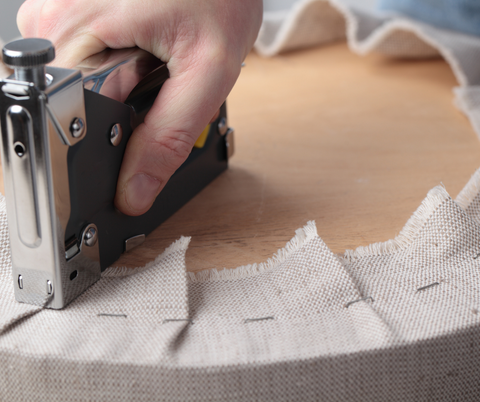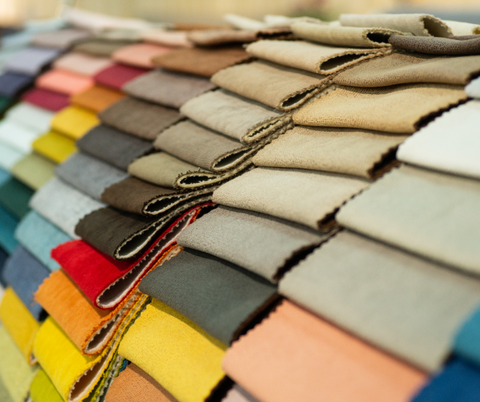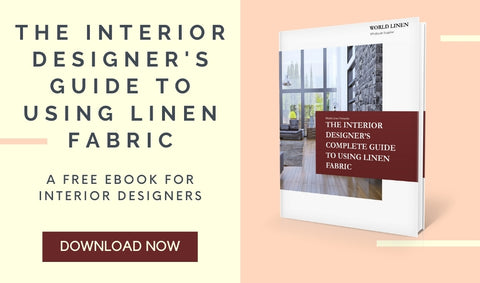If you’re diving into a large-scale project, it can feel like a race against the clock. Craving diverse fabric and color options while juggling budget constraints can add layers of complexity.
Wholesale upholstery fabric might just be the magic thread you’re looking for.
Wholesale upholstery fabric may be right for your project if …
- You have a large-scale project
- Budget constraints are a concern
- You are looking for a variety of fabric and color options
- You need to meet fire codes and other regulations
- You require quick turn-around times
Wholesale Upholstery Fabric For Large-Scale Projects
For designers tackling large-scale projects, wholesale upholstery fabric can be a great option to get the quantities of upholstery fabric you need. When undertaking projects like hotels, office complexes or residential developments, designers often require substantial quantities of fabric to furnish spaces effectively.

Wholesale suppliers can accommodate these demands, providing access to vast inventories that ensure consistency across every inch of the project.
When buying fabric in wholesale quantities, you typically have two options available to you: purchasing through a wholesale supplier/manufacturer or through a distributor.
A manufacturer or wholesale supplier produces upholstery fabrics in bulk and sells them to distributors or retailers. Designers can pick up upholstery fabric at a lower cost, but be mindful of minimum order requirements. If your project doesn’t meet the minimum order requirements to purchase through a particular supplier, you’ll need to turn to a distributor.
A distributor is an intermediary that purchases upholstery fabrics from manufacturers or wholesale suppliers and then sells that fabric to an end user, whether that’s you as a designer or a retailer. Distributors play an important role in supply chain management, ensuring efficient supplies are available. However, the downside to purchasing from a distributor is that the intermediary often marks up the wholesale price before selling it to you. So while you may meet the minimum order requirements, you’ll pay more for your upholstery fabric.
Budget Constraints When Buying Upholstery Fabric
That leads us into our next consideration when weighing whether wholesale upholstery fabric is right for you.
If you or your client has budget constraints, buying fabric at wholesale prices can help alleviate those financial pressures. By accessing fabrics through wholesale channels, you can benefit from significantly lower costs when buying upholstery fabric by the yard or wholesale fabric by the bolt compared to retail options.
In fact, retail options are typically your most expensive choice since they must again mark up the price based on what they paid the distributor. Retail chains also often lack upholstery fabric in large quantities.
The cost-effectiveness of ordering wholesale fabric extends a lifeline to designers navigating projects with tight budgetary parameters, enabling them to stretch their resources further without sacrificing quality or design integrity.
Fabric And Color Options In Wholesale Fabric
There’s a misconception that when you buy wholesale you give up the ability to customize. Nothing could be further from the truth. The best wholesale fabric manufacturers will offer you the opportunity to personalize your order so that it aligns precisely with your creative vision and project requirements.

Wholesale fabric suppliers understand that every project is unique, and designers often have specific preferences when it comes to color, pattern, texture and material composition. To address this diversity of needs, reputable wholesale manufacturers provide quality customization options, ensuring that designers have the freedom to tailor fabrics to their exact specifications.
For example, color allows designers to infuse their clients’ unique tastes and personality into a sofa, accent chair or outdoor furniture piece. However, as a designer, it’s important that you do not rely on the manufacturer’s website for color. It is always better to request a color swatch or sample so that you are more likely to receive the color you desire. Dye lot variations are common in the textile industry, and color shifts can happen with “stock” colors.
Another method to customizing upholstered furniture is by taking advantage of custom printing. Custom printing can be used on a variety of upholstered pieces, including projects that incorporate window draperies, ottomans, wallpaper and other home decor items.
There are two types of printing services available: Rotary/flat bed printing and digital printing.
Rotary/flat bed printing is a direct-to-fabric printing technique where the image is engraved on precision cut stencils, also known as screens. Multiple screens can be used to create a multi-color design and can produce vivid colors and intricate designs on your upholstery fabric. Crisp lines and detailed images are created using screen printing, allowing inks to penetrate the fabric and hold color better and longer.
Digital printing on fabric is also known as DTG, or direct-to-garment printing. Digital printing is any ink-jet based method of printing colorants onto fabric. This process allows for lower minimums, eliminates screen charges and removes the need for screen storage.
Finally, don’t forget about other fabric customizations that prevent seams from slipping and add durability. For example, latex backing is commonly used on furniture upholstery since the coating helps prevent soil from sifting through the fabric.
Protective coatings can lengthen the lifespan of an upholstered piece by protecting it against everyday dirt and grime. Nano coating is a popular protective finish on upholstery fabric used in homes and offices since it helps to repel dry particles, water, oil and dirt. Other options include Scotchgard and Alta treatments.
Options For Meeting Fire Codes And Regulations
When designing for commercial projects, it’s important to take into consideration any fire codes and regulations required. The good news is that you can buy wholesale upholstery fabric that meets these standards designed to ensure public safety.
In the state of California, furniture must comply with TB117-2013. This fire rating regulation requires that upholstery fabric pass smolder cigarette tests. As you work with an upholstery fabric supplier, ensure that the fabric you are selecting can meet the requirements of this law.
Fabrics used on furniture pieces and accessories in public places must also meet fire safety standards. The National Fire Protection Association sets these standards, which cover areas like the flammability of fabrics and the fire performance of complete upholstered furniture assemblies, including the fabric, padding and frame.
Fire retardant applications are also required under California law for public spaces. Keep in mind that there is a difference between fire retardant applications and fire resistant applications. The two terms are NOT interchangeable. Fire retardant applications typically work by chemically altering the material to make it more difficult to ignite or by creating a protective barrier that prevents flames from spreading. Fire-resistant materials are inherently designed to resist combustion or to withstand fire for a specified period without burning or melting.
Fire retardant applications can be sprayed on or brushed on and help limit the spread of a fire. Rather than igniting, the fabric is protected under intense heat.
Key To Quick Turn-Around Times
While heading to a local retail store to buy fabric is the fastest choice, you likely won’t get the quantities of fabric you need at your desired price. You can still get wholesale upholstery fabric from a supplier - even customized fabric - within reasonable lead times.
However, it’s important that you check with any company you’re considering purchasing fabric from to ensure you will get the fabric you need within any time constraints that you have for your project.
So what can impact turn-around times? The location of the supplier is a major consideration. Ordering from a supplier overseas can delay your order. A number of factors impact lead time when ordering overseas, including unforeseen customs issues or delays or simply longer shipping times. When working with a domestic supplier, you can skip customs and shipping times are likely shorter.
The quality of the supplier you are working with also impacts how quickly you receive your order and how well your supplier communicates with you regarding an expected timeline. Here’s where communication is key. Establishing clear and open lines of communication with your wholesale fabric supplier is important for ensuring timely delivery and a smooth ordering process.
A reputable supplier will have efficient production processes and sufficient stock to fulfill orders promptly, minimizing delays. The top wholesale fabric suppliers will keep you updated on the status of your order, alerting you to any potential delays or issues that may arise. Transparency regarding production schedules, shipping timelines and any unforeseen challenges enables you to plan accordingly and adjust your project timeline as needed.





